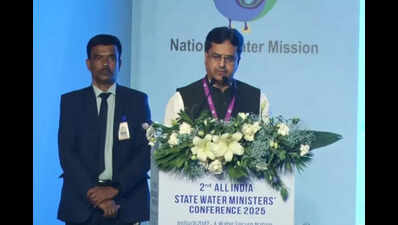- News
- City News
- agartala News
- Level of extractable groundwater increased in Tripura: CM Manik Saha
Trending
Level of extractable groundwater increased in Tripura: CM Manik Saha
Tripura's annual groundwater resources have substantially increased due to scientific recharge actions. Chief Minister Dr. Manik Saha aims for 80% irrigation coverage of cultivable land. The state focuses on rainwater storage and minor irrigation projects while implementing water conservation measures. Amid flooding challenges, flood protection embankments and a state-specific action plan are being developed for sustainable water management.
AGARTALA: Tripura Chief Minister Dr Manik Saha on Tuesday said that the annual extractable dynamic groundwater resources in Tripura have increased substantially over the year while
While addressing 2ndAll India State Water Ministers Conference at Rajasthan’s Udaipur, Dr Saha quoted statics saying, the amount of groundwater pulling out the level of groundwater has increased to 1.18 billion cubic meters in 2024, which was 1.063 billion cubic meters in the previous year because of scientific groundwater recharge actions at different levels.
“We have set a target of achieving 80% irrigation coverage of cultivable land in the next few years, as Tripura heavily relies on agriculture for its economy, and the state government is prioritizing irrigation projects to boost agricultural productivity and enhance farmers’ incomes,” Dr Saha said.
Currently, 25% of Tripura’s total geographical area is cultivable, with 47% of this land benefiting from irrigation. Due to the state’s fast-flowing rivers and limited water storage capacity, large-scale surface water irrigation projects are not feasible. Instead, the government is focusing on developing rainwater storage structures and minor irrigation dams.
To maximize this resource, the state government has undertaken deep tube well projects for both irrigation and drinking water. Since the launch of the Jal Shakti Abhiyan – Catch The Rain initiative, annual extractable dynamic groundwater resources have increased.
The state government has also implemented various measures for water conservation, including rainwater harvesting, renovation of traditional water bodies, watershed development, and large-scale afforestation efforts.
Tripura’s 10 major rivers, while crucial water sources, also pose challenges due to their rapid flow. During the monsoon, these rivers often cause severe erosion and flooding. Last year, Tripura experienced record-breaking rainfall, leading to unprecedented flood levels and extensive damage. Now proactive steps to mitigate the impact of floods by constructing 43 flood protection embankments and implementing anti-erosion measures along riverbanks.
“To ensure integrated and sustainable water resource management, we are developing a state-specific action plan with a long-term vision for 2047. This plan will address water resource management, bridge demand-supply gaps, and incorporate strategies to tackle climate change challenges,” Dr. Saha concluded.
Stay updated with breaking news, weather updates, bank holidays and upcoming public holidays in march.
End of Article
FOLLOW US ON SOCIAL MEDIA







